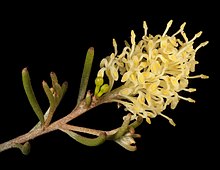| Grevillea incrassata | |
|---|---|

| |
| In Frank Hann National Park | |
| Conservation status | |
 Vulnerable (IUCN 3.1) | |
| Scientific classification | |
| Kingdom: | Plantae |
| Clade: | Tracheophytes |
| Clade: | Angiosperms |
| Clade: | Eudicots |
| Order: | Proteales |
| Family: | Proteaceae |
| Genus: | Grevillea |
| Species: | G. incrassata |
| Binomial name | |
| Grevillea incrassata Diels | |
Grevillea incrassata is a species of flowering plant in the family Proteaceae and is endemic to inland south-western Western Australia. It is an erect shrub with crowded cylindrical or narrowly linear leaves and clusters of bright yellow flowers.
Description
Grevillea inconspicua is an erect shrub that typically grows to a height of 0.3–2.3 m (1 ft 0 in – 7 ft 7 in) and has silky-hairy branchlets. The leaves are crowded and circular in cross-section or linear, 5–25 mm (0.20–0.98 in) long, 0.5–1.5 mm (0.020–0.059 in) wide and silky-hairy. The flowers are arranged in usually branched clusters 10–20 mm (0.39–0.79 in) long on the ends of branches and are bright yellow or golden yellow, the pistil about 7 mm (0.28 in) long. Flowering occurs from September to November and the fruit is a cylindrical to oval follicle 10–16 mm (0.39–0.63 in) long.
Taxonomy
Grevillea incrassata was first formally described in 1904 by Ludwig Diels in Ernst Georg Pritzel's Botanische Jahrbücher für Systematik, Pflanzengeschichte und Pflanzengeographie. The specific epithet (incrassata) means "flattened", referring to the leaves.
Distribution and habitat
This grevillea grows in scrub mallee on sandplains between Narembeen, Southern Cross, Lake King and Peak Charles National Park in the Avon Wheatbelt, Coolgardie, Esperance Plains and Mallee bioregions of inland south-western Western Australia.
Conservation status
Grevillea incrassata is listed as "not threatened" by the Government of Western Australia Department of Biodiversity, Conservation and Attractions but as Vulnerable on the IUCN Red List of Threatened Species. This is due to an estimated decline in population of 30% over the past three generational lengths due to land clearing for agriculture and competition with invasive weeds.
The population is currently stable and occurs within multiple protected areas, though it is restricted to road verges within the Wheatbelt region. Here, it is threatened by verge clearance and weed invasion.
See also
References
- ^ Keighery, G.; Olde, P. (2020). "Grevillea incrassata". IUCN Red List of Threatened Species. 2020: e.T113021453A113308121. doi:10.2305/IUCN.UK.2020-2.RLTS.T113021453A113308121.en. Retrieved 25 January 2024.
- "Grevillea incrassata". Australian Plant Census. Retrieved 22 May 2022.
- ^ "Grevillea incrassata". FloraBase. Western Australian Government Department of Biodiversity, Conservation and Attractions.
- ^ "Grevillea incrassata". Australian Biological Resources Study, Department of Agriculture, Water and the Environment: Canberra. Retrieved 22 May 2022.
- "Grevillea incrassata". APNI. Retrieved 22 May 2022.
- Diels, Ludwig (1904). "Fragmenta Phytographiae Australiae occidentalis. Beitrage zur Kenntnis der Pflanzen Westaustraliens, ihrer Verbreitung und ihrer Lebensverhaltnisse". Botanische Jahrbücher für Systematik, Pflanzengeschichte und Pflanzengeographie. 35 (1): 156. Retrieved 22 May 2022.
- Sharr, Francis Aubi; George, Alex (2019). Western Australian Plant Names and Their Meanings (3rd ed.). Kardinya, WA: Four Gables Press. p. 223. ISBN 9780958034180.
| Taxon identifiers | |
|---|---|
| Grevillea incrassata | |